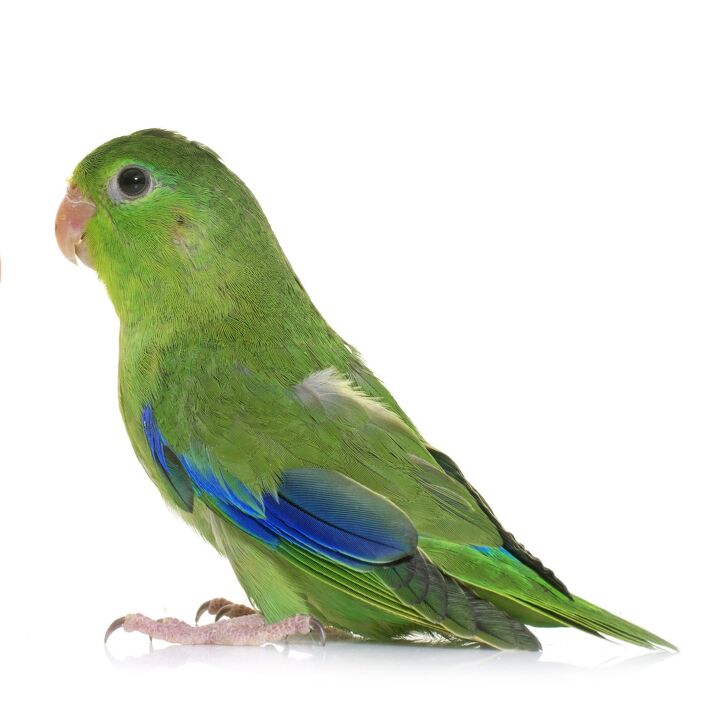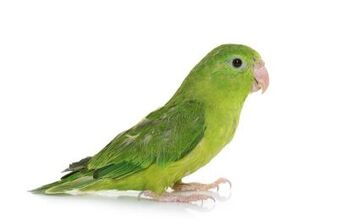Celestial Parrotlet


About Celestial Parrotlet
If there was a reward for the cutest parrot in the pet world, the Celestial Parrotlet would always be a champion. These tiny, pocket-sized parrots are the absolute charmers in aviculture. They are cuddly, goofy and full of energy. It’s not really surprising that these parrots are highly popular pets and the stars of many viral videos. Full of fun, affection and many lovable traits, parrotlets easily achieve a bond with their owners and become the heart of every family. Let’s meet these tiny goofballs!
Parrotlets are the second smallest parrot species. They are truly pocket-sized, so always keep an eye on them.
Native Region/Natural Habitat
These South American parrots inhabit a wide region that is centered around Ecuador, Southwestern Colombia and Peru. Celestial Parrotlet thrives on the Pacific slopes of the Andes, coastal mangroves, scrubland and banana, and mango plantations as well. Parrotlets are one of the cavity-nesting species, as they prefer to lay their eggs in tree holes, cactuses or abandoned nests.
Almost all Parrotlet breeds are similar in their appearance, often differing only in their colors. They have a few distinct physical aspects, which combined with their small size, makes them easy to recognize. The adults reach an average length of just 5 inches (12 centimeters) and will weigh a mere ounce (30 grams). While they won’t take up a lot of space and will require only a moderate cage, Celestial Parrotlet is still full of energy. A time out of the cage is a must, but so is your attention. These tiny mischievous goofs will love to hide, explore and get into all kinds of trouble. Keep an eye out!
An advantage of small parrot breeds is the smaller they are – the quieter they get. The Celestial Parrotlet is a great apartment pet. They have a variety of natural calls, but almost all of them are melodious chirps and miniature shrieks. None of these are significantly loud and are easily overlooked. But they are not a talking breed. Don’t count on any mimics or words from your pet – they are simply too small for any of that.
Parrotlets are amongst the simplest species when it comes to colors. While they are undoubtedly the biggest charmers, don’t expect any flashy combinations or exotic patterns. The body has a lot of light, wispy colors. The chest and abdomen are light grayish green, with much darker shades on the wings. Their face is a pastel green, with the unique light violet color on the back of the head. The rump and the tips of the flight feathers are cobalt blue.
The females are slightly different, with almost no blue colors and a lot more of the green. For anyone who is looking for something more vibrant, there are a lot of artificial color mutations. A lot of pet stores offer Celestial Parrotlet in all blue, green and yellow. But whatever your choice – you’ll end up with a charming little bird.
With major differences in coloration, the males and females are easily recognized.
In the wild, these parrots feed on a variety of grass seeds, berries, fruits, and agricultural crops. They are often targeted as pests – as they have a tendency to invade gardens and plantations in more populated areas. A balanced diet for your Celestial Parrotlet should be started with a commercial seed mix with a good amount of millet, canary seeds, oats, and buckwheat. Safflower, hemp and similar seeds can work as well.
The second part of a balanced diet is in the vitamins. These are found in fresh greenery such as cabbage, lettuce, dandelions, and chard. Put in some apples, oranges, and pears for good measure, and you’ll have a perfectly balanced diet for your pet. Remember that, because of the tiny size of the Celestial Parrotlet, all foods should be chopped to a fine, almost mushy consistency.
It is easy to make a mistake with these small and cute looking parrots, and think that their health is fragile. But that is far from the truth. With plenty of good care and attention, and with a balanced diet, a Celestial Parrotlet will live up to 25 years without many troubles along the way. With optimized conditions and enough interaction, you will realize that parrotlets are in fact quite easy to take care of. The main threat is their small size. Always be on guard when they are out and about, to prevent any accidents like squishing them.
Celestial Parrotlet can be really mischievous and inquisitive. That’s why you shouldn’t leave them unattended – otherwise, they’ll get in trouble quickly.
Besides their incredible cuteness, these parrotlets are also popular because of their lively personality. They are vibrant and full of positive energy which is manifested through silly tricks and a bit of cuddliness as well. Celestial Parrotlet will love to crawl into small spaces and snuggle up to you beneath the blankets. Combined with their small size and ease of looking after them, they prove to be a truly fantastic pet parrot that adapts to all settings and leaves little to be desired. So, if you are looking for a parrot that isn’t so exotic and large, but has a fun and loving personality, then the Celestial Parrotlet is the choice for you!
Photo credit: Ploychan Lompong/Shutterstock; cynoclub/Shutterstock

A proud mama to seven dogs and ten cats, Angela spends her days writing for her fellow pet parents and pampering her furballs, all of whom are rescues. When she's not gushing over her adorable cats or playing with her dogs, she can be found curled up with a good fantasy book.
More by Angela Vuckovic

























